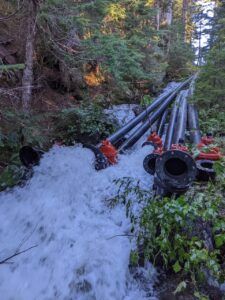The lake providing water to 90% of the population on the Sunshine Coast is seeing the lowest levels in history.
The lake provides water to District of Sechelt, shíshálh Nation, Halfmoon Bay, Roberts Creek, Elphinstone and West Howe Sound— which are all connected to the Chapman Water System.
Water from another lake is being pumped into Chapman. The Town of Gibsons has also been providing water to the Chapman system since September of this year.
“We have a siphon system in place there, we’ve been using it since late July,” said Remko Rosenboom, Water Manager for the Sunshine Coast Regional District. “We’re currently installing and commissioning a similar system at Edwards [Lake]. It’s a temporary measure, an emergency measure, we’re only allowed to use this year. Next year, we have to figure it out again. The water from Edwards Lake is actually going directly into Chapman Creek.”

The temporary siphon system will be in place until the end of 2023, says Rosenboom, and as soon as water levels rise, they have to take it out. The Edwards siphon has a budget of $360,000, with $100,000 of that budget saved to take it out next year again.
Rosenboom estimates the measure gives them about two-and-a-half weeks of water, and believes the system will be alright until November rolls around.
“The water levels in Chapman Lake are extremely low, we never dreamed they’d be as low as they are right now. That is concerning,” said Rosenboom. “Edwards Lake, our second major water supply, is being drawn down at the moment at a pace we haven’t seen before. Things are unprecedented, to say the least.”
He says it would require 4 or 5 days of 25ml worth of heavy rain each day to fully ‘recharge’ the lake.
“You have to imagine the soil of the watershed as a sponge, so if you pour a little bit of water on the sponge, the sponge will not give you anything back. It will just absorb it. That’s what happens. So, that’s why we need a significant amount of rain for the watershed to really saturate before they actually release the water to the creek for us.”
Rosenboom says the weather forecast looks like it’ll be warmer than usual, and the SCRD is exploring options at the moment about what to do.
He says one emergency measure would be to place pumps in the lake, but it would require fuel and generators. Another option being considered is getting water from other water systems. They are also considering a state of emergency, as it would allow the district to regulate the water use within the community ‘differently’ compared to right now.
“In a state of emergency, we might be able to shut off water to certain businesses, for example. Under stage three [water restrictions], car washes for example are not allowed to operate— or they’re not allowed to use SCRD water. But, there might be other businesses that are using water at the moment that in a crisis situation, when an emergency’s declared, we have to say ‘sorry, but residents, hospitals, and firefighting— that’s where the water needs to go.’”
The full interview is available here.


